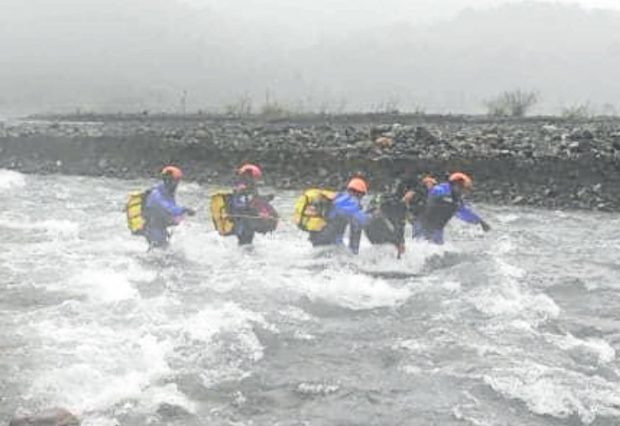
RESCUE EFFORT | Despite the bad weather, ground search members endure crossing swollen rivers and treacherous terrain on Saturday, Jan. 28, 2023, as they continue to search for the missing Cessna plane at the Sierra Madre mountain range in Divilacan, Isabela. (Photo courtesy of the Philippine Army’s 95th Infantry Battalion of the 5th Infantry Division)
CAUAYAN CITY, Isabela, Philippines — Authorities said on Sunday that the combined effects of the northeast monsoon and shear line have stalled the ground and aerial searches for the missing Cessna plane and its six passengers at the Sierra Madre mountain ranges that were deployed on Saturday.
Lawyer Constante Foronda, Isabela provincial disaster risk reduction and management officer and incident management team commander, said in an interview on Sunday that they were zeroing in on the latest confirmed information about a white aircraft spotted at 6:45 a.m. along the Sierra Madre side of Sapinit village in Divilacan town.
On Saturday, the ground search teams began the trek toward the forested site in Divilacan’s village of Dicaruyan, which adjoins Sapinit, where the missing plane was believed to have crashed.
The ground team was deployed after two aerial searches by military helicopters failed to find the aircraft due to the thick and hazy clouds and unpredictable weather, Foronda has said at a news briefing at the Tactical Operations Group 2 compound here.
The RP-C1174 Cessna took off from Cauayan Airport at 2:16 p.m. on Jan. 24 and was expected to land at the airport of Maconacon town, also in Isabela province, at 3 p.m. that day. But it went off the radar an hour after leaving Cauayan.
The plane’s pilot was identified as Capt. Eleazar Mark Joven and the five passengers as Val Kamatoy, 34; Kamatoy’s nephews Rom Josthle Manday, 15, and siblings Mark Eiron Siguerra, 20, and Xam Siguerra, 10; and Josefa Perla España.
Hope springs eternal
The members of the search and rescue team, which left at noon on Saturday, were hoping to reach the “alpha site” or the priority area at 4 p.m. but they were forced to halt their ascent at nightfall and set up camp because the prevailing bad weather caused temperature to drop and triggered rains.
The trek continued on Sunday toward the site of the wreckage believed to be within the 25-kilometer radius of the unfinished Ilagan-Divilacan road project.
Earlier, Foronda said a farmer saw the plane, which matched the description of the missing six-seat Gen AV Cessna 206, heading for the Pacific Ocean before it swirled toward the Sierra Madre mountain ranges.
Foronda on Sunday said they have not given up hope to find survivors.
The ground team even brought ready-to-eat food packs and other gadgets for the rescue and retrieval of the pilot and passengers.
The aerial search would have to wait until the weather improves, he added.
The long-range drone owned by the Department of Environment and Natural Resources was still being used in the search but hazy clouds and bad weather also hindered their succeeding air flights.
“The aerial search planes could not penetrate [the hazy clouds] while the ground forces confront the bad weather until now. Yet, they will continue [the] attempts [to find the plane],” said Army Capt. Rigor Pamittan, 5th Infantry Division spokesperson, on Sunday.
Foronda, in Saturday’s briefing, had said that their “primary concern” was to “immediately reach the area” and assist survivors, if there were any.